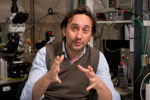

Goal-directed behaviours rely critically on internal representations of the surrounding space. While we understand increasingly well how neurons represent space, how brains construct such spatial representations and use them to guide action remains unknown. Here, we plan to investigate the transformation of neural spatial representations into actions, and how such representations emerge from sensorimotor experience.
In this project, the candidate will build on our recent work on the superior colliculus to explore how genetically defined collicular neurons and broader cortico-collicular circuits contribute to action in space. Using cutting-edge tools, including high-density electrophysiology, optogenetics, viral tracing, multiphoton imaging, and holographic stimulation, they will map, record and manipulate neural circuits in vivo. Leveraging the lab’s novel behavioural paradigms and recording methods, the candidate will dissect how spatial representations are transformed into action.
References
Kinetic features dictate sensorimotor alignment in the superior colliculus
Nature 631(8020): 378-385 (2024)
Collicular circuits supporting the perceptual, motor and cognitive demands of ethological environments.
Curr Opin Neurobiol 82: 102773 (2023)
Combining long-term circuit mapping and network transcriptomics with SiR-N2c
Nature Methods 20(4): 580-589 (2023)
Genetically Defined Functional Modules for Spatial Orienting in the Mouse Superior Colliculus.
Curr Biol 29(17): 2892-2904.e8 (2019)